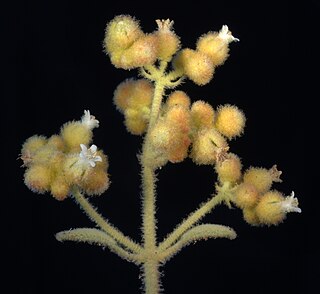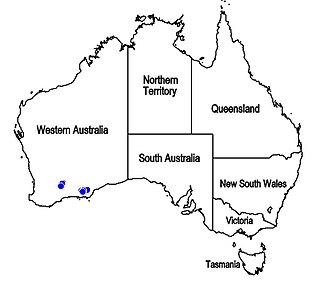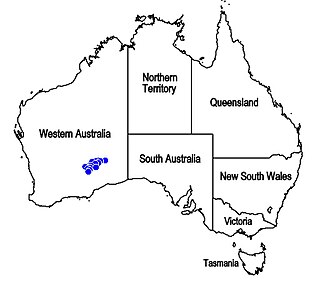
Dicrastylis is a genus of plants in the Lamiaceae, first described in 1855. The entire genus is endemic to Australia.

Pityrodia augustensis, commonly known as Mount Augustus foxglove, is a flowering plant in the mint family Lamiaceae and is endemic to a small area in Western Australia. It is a small, bushy shrub with its branches, leaves and some of its flower parts densely covered with woolly hairs. It is similar to the lovely foxglove and the sandplain foxglove but has very different leaves from those species.
Dasymalla axillaris, commonly known as native foxglove or woolly foxglove, is a flowering plant in the mint family Lamiaceae and is endemic to Western Australia. It is a small, diffuse shrub with its branches, leaves and some of its flower parts densely covered with white, woolly hairs. The flowers are a shade of red and tube-shaped with the stamens and style extending beyond the end of the five petals.

Muniria is a genus of four species of flowering plants in the mint family, Lamiaceae and is endemic to the Northern Territory in Australia. Plants in this genus are woolly shrubs with five petals joined to form a tube-shaped flower with four stamens of unequal lengths. These species are similar to those in the genus Pityrodia except that the branches are distinctly 4-angled in cross section and the fruit has calluses or ridges.
Dasymalla chorisepala is a flowering plant in the mint family Lamiaceae and is endemic to Western Australia and the Northern Territory. It is a small shrub with its branches and leaves densely covered with hairs. The leaves are stalkless, egg-shaped and covered with yellowish hairs while the flowers are small, tube-shaped and white.
Muniria megalophylla is a flowering plant in the mint family Lamiaceae and is endemic to Arnhem Land in the Northern Territory. It is a shrub with its branches and leaves densely covered with a layer of short, greyish, branched hairs and small groups of reddish-pink flowers near the ends of the branches.

Dicrastylis exsuccosa is a species of plant within the genus, Dicrastylis, in the family Lamiaceae. It is endemic to inland Australia and found in Western Australia, the Northern Territory and South Australia.

Dicrastylis rugosifolia is a species of plant within the genus, Dicrastylis, in the family Lamiaceae. It is endemic to the south-west of Western Australia.

Dicrastylis archeri is a species of plant within the genus, Dicrastylis, in the family Lamiaceae. It is endemic to the south-west of Western Australia.

Dicrastylis capitellata is a species of plant within the genus, Dicrastylis, in the family Lamiaceae. It is endemic to the south of Western Australia.

Dicrastylis cordifolia is a species of plant within the genus, Dicrastylis, in the family Lamiaceae. It is endemic to the north of Western Australia.

Dicrastylis doranii is a species of plant within the genus, Dicrastylis, in the family Lamiaceae. It is found in Western Australia, the Northern Territory, and South Australia.

Dicrastylis incana is a species of plant within the genus, Dicrastylis, in the family Lamiaceae. It is endemic to Western Australia.

Dicrastylis linearifolia is a species of plant within the genus, Dicrastylis, in the family Lamiaceae. It is endemic to Western Australia.

Dicrastylis lewellinii is a species of plant within the genus, Dicrastylis, in the family Lamiaceae. It is found in Western Australia, the Northern Territory, New South Wales, Queensland and South Australia.

Dicrastylis corymbosa is a species of plant within the genus, Dicrastylis, in the family Lamiaceae. It is endemic to Western Australia.

Dicrastylis costelloi is a species of plant within the genus, Dicrastylis, in the family Lamiaceae. It is found in Western Australia, South Australia, the Northern Territory and Queensland.

Dicrastylis cundeeleensis is a species of plant within the genus, Dicrastylis, in the family Lamiaceae. It is endemic to the south of Western Australia.

Dicrastylis kumarinensis is a species of plant within the genus, Dicrastylis, in the family Lamiaceae. It is endemic to Western Australia.

Dicrastylis soliparma is a species of plant within the genus, Dicrastylis, in the family Lamiaceae. It is endemic to Western Australia.


















